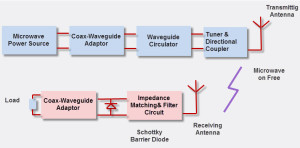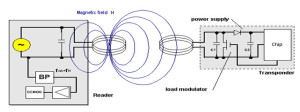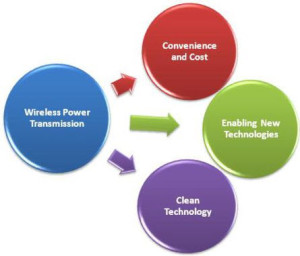
Wireless Power Transmission
Nowadays electricity is considered as one of the basic needs of human beings. The conventional power transmission system uses transmission lines to carry the power from one place to another, but it is costlier in terms of cable costs and also there exists a certain transmission loss. One maintainable technology leading this charge is a wireless power transmission (WPT) . It is also known as inductive power transfer (IPT).
Wireless Power Transmission Technology
Wireless power transmission technology is not a new technology. In 1980, it was demonstrated by Nikola Telsa. There are three main systems used for wireless electricity transmission: solar cells, microwaves and resonance. In an electrical device, microwaves are used to transmit electromagnetic radiation from a source to a receiver. The name wireless power transmission states the transfer of electrical power from a source to an electrical device without the help of wires. Basically, it involves two coils: a transmitter and a receiver coil. The transmitter coil is powered by an AC current to produce a magnetic field, which in turn induces a voltage in the receiver coil.
The basics of WPT involve the inductive energy transmission from a transmitter to a receiver through an oscillating magnetic field. To get this DC current, that is supplied by a power source, it is converted into high -frequency AC current by the specially designed electronics built into the transmitter.
In the transmitter section, the AC current boosts a copper wire, which generates a magnetic field. Once a receiver coil is placed within the close vicinity of the magnetic field, the field can induce an AC current in the receiving coil. The electrons in the receiving device, then converts the AC current back into DC current, which becomes utilizable power.
Types of Wireless Power Transmission Methods:
There are different types of wireless power transmission methods: microwave power transmission, inductive-coupling-power transmission and laser-power transmission methods.
1. Microwave Power Transmission
William C Brown, the pioneer in the WPT technology, has designed and exhibited to show how power can be transmitted through free space by microwaves. The concept of the WPT is explained with a functional block diagram which is shown below.

Microwave Power Transmission
The functional block diagram of WPT consists of two sections: transmitting section and receiving section. In the transmission section, the microwave power source generates microwave power which is controlled by the electronic control circuits. The waveguide circulator protects the microwave source from the reflected power, which is connected through the co-ax waveguide adaptor. The tuner contests the impedance between the microwave source and transmitting antenna. Then, based on the signal propagation direction, the attenuated signals are separated by the directional coupler. The transmitting antenna emits the power regularly through free space to the receiving antenna.
In the receiving section, the receiving antenna receives the transmitted power and converts the microwave power into DC power. The filter and impedance matching circuit is provided for setting the output impedance of a signal source which is equal to rectifying circuit. This circuit consists of Schottky barrier diodes which converts the received microwave power into DC power.
2. Inductive Coupling Power Transmission:
Inductive coupling method is the most important methods transferring energy wirelessly through inductive coupling. Basically, it is used for near -field power transmission. The power transmission takes place between the two conductive materials through mutual inductance. The general example of inductive coupling power transmission is a transformer.

Inductive Coupling Power Transmission
3. Laser Power Transmission:
In this type of power transmission method, a LASER is used to transfer power in the form of light energy, and the power is converted to electric energy at the receiver end. The LASER gets powered using different sources like sun, electricity generator or high-intensity-focused light. The size and shape of the beam are decided by a set of optics. The transmitted LASER light is received by the photo-voltaic cells, that converts the light into electrical signals. Usually, it uses optical-fiber cables for transmission.

Laser Power Transmission System
Working Example of Wireless Power Transfer
The main intention of this project is to develop a system of wireless power transmission in 3D space.

Block Diagram of Wireless Power Transfer
Hardware requirements include HF transformer, diode, rectifier, capacitors, transformers, lamp and air filled inductor coil.
This project requires an AC 230V 50Hz to AC 20 KHz at 12V circuit. The AC, 50Hz is rectified by a BR1 and the DC is derived again, and then made to AC by transistors switching at 40KHz. This is connected to another HF transformer( high frequency) . The output of which is then fed to a resonating coil which acts as a primary of another air-core transformer. Then, the secondary high frequency ID is fed to a second rectifier to drive a DC load.
The main concept of this wireless power transfer in 3D space is, air core transformer operates at 40KHz and by the air core, one cannot transfer 50Hz AC power
The secondary coil magnetic resonance develops a voltage of 40KHz at about 12V while taking over the primary coil. But, the overall efficiency of the power transfer is below 70% for all weakly coupled series resonators that are used in this project
Benefits of WPT:
- WPT system completely reduces existing high-tension power transmission cables, substations and towers between the consumers and generating station.
- The cost of the distribution and transmission become less.
- The cost of the electrical energy to the consumers also reduces.
- The power could be transmitted to places to which the wired transmission is not possible.

Benifits of Wireless Power Transmission
Applications of Wireless Power Transmission:
- The largest application of the WPT is the production of power by placing satellites with giant solar arrays in Geosynchronous Earth Orbit and transmitting the power as microwaves to the earth known as Solar Power Satellites (SPS).
- WPT is used in moving targets like fuel-free-electric vehicles, fuel- free airplanes, fuel-free rockets and moving robots.
- The other applications of WPT are Wireless power source or Ubiquitous Power Source, RF Power Adaptive Rectifying Circuits and Wireless sensors.
In this way, one can design a wireless-power-transfer system for simple electronic devices like mobile charges, mobile phones which not only reduces the risk of shock, but also the efforts to plug repeatedly into the sockets. We hope that this article might have provided some basic insights about the wireless power transfer to you.
Know more about Power System MCQs.
Photo Credits:
- Wireless Power Transmission by wpc
- Benefits of WPT by dolcera